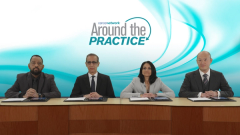
Transplantation and Graft-vs-Host Disease
A panel of experts and a patient with graft-vs-host disease discuss the relationship between transplantation and GVHD.
Episodes in this series

Transcript:
Preet M. Chaudhary, MD, PhD: Welcome to this Cancer Network® Around the Practice® presentation titled “The Treatment of GVHD: Expert and Patient Perspectives.” I’m your host, Dr Preet Chaudhary. I’m the chief of hematology and director of bone marrow transplant and cell therapy at the University of Southern California [USC] in Los Angeles. Joining me today is Lakshmi.
Lakshmi Savitala-Damerla, PA-C: Hi, I’m Lakshmi Savitala-Damerla. I’m a physician assistant at USC Norris Cancer Center. I work with the bone marrow transplant team.
Preet M. Chaudhary, MD, PhD: AndDr Eric Tam.
Eric Leon Tam, MD: Hi, I’m Eric Tam. I’m an assistant professor in the division of hematology and bone marrow transplant at the University of Southern California.
Preet M. Chaudhary, MD, PhD: And Hector.
Hector Cuevas: Hi, my name is Hector Cuevas, and I’m the patient.
Preet M. Chaudhary, MD, PhD: Today we’re going to review background information on transplantation and graft-vs-host disease and review treatment options. We’ll discuss the information we’re using to make treatment decisions and how to best work with patients and caregivers. Let’s begin.
At our center, we use bone marrow transplants for the treatment of a large number of diseases, such as lymphoma, multiple myeloma, acute and chronic leukemias, aplastic anemia, and occasionally germ cell tumors. Hector, can you share a bit about your initial diagnosis?
Hector Cuevas: When I found out about my diagnosis, I had a ball on my groin. I had to go to the hospital for that because it was hurting. That’s when I found out that I had several on the back of my neck and on the bottom of my armpit. That’s when I was diagnosed with leukemia.
Preet M. Chaudhary, MD, PhD: What concern did you have initially about the diagnosis?
Hector Cuevas: The first thing that came to my mind is that I’m going to die. That was my biggest concern.
Preet M. Chaudhary, MD, PhD: Dr Tam, what are the different types of allogeneic transplants that you use in your practice?
Eric Leon Tam, MD: There are several types of transplants. To be clear, we’re talking about allogeneic stem cell transplants, not autologous stem cell transplants, which are a little different. For allogeneic stem cell transplants using donors, we usually do a source from the peripheral blood from the donor or from the bone marrow from the donor. There are also different sources that we can take from the different types of donors. We have matched related donors, who are related to the donor or to the recipient. We also have matched unrelated donors, which come from the registry. These are individuals who have volunteered to donate their bone marrow across the country. We can also do haploidentical and cord blood. At USC, we don’t do cord blood. This is the blood taken from the umbilical cord from infants when they’re born. We do haploidentical. These are half-matched individuals, so they could be a son, a daughter, or a parent for this patient.
Preet M. Chaudhary, MD, PhD: In your experience, which kind of transplant has a higher incidence of graft-vs-host disease?
Eric Leon Tam, MD: Among the different types of transplants, the mismatched donors will have the highest level of graft-vs-host disease. The haploidentical donors will also have the highest levels of graft-vs-host disease. There are ways to try to minimize that now, but because of that mismatch the immune is thought to react higher and cause more problems down the road.
Preet M. Chaudhary, MD, PhD: Hector, what treatment did you receive prior to your transplant?
Hector Cuevas: I received chemotherapy and radiation. That’s about it.
Preet M. Chaudhary, MD, PhD: What kind of transplant did you have?
Hector Cuevas: I had the bone marrow transplant.
Transcript edited for clarity.
Newsletter
Stay up to date on recent advances in the multidisciplinary approach to cancer.


































































































